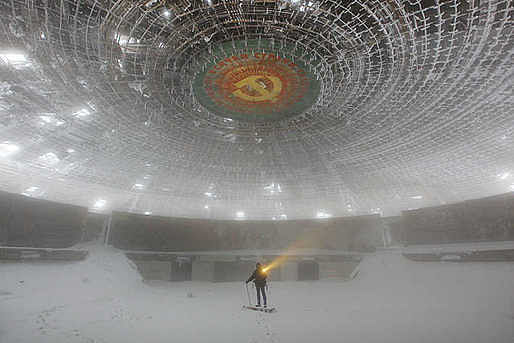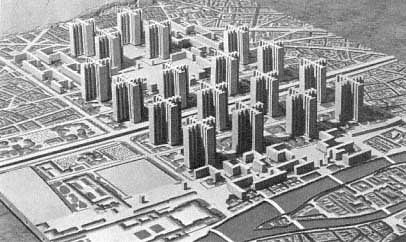
The SOM Prize is an annual $50 000 fellowship allowing a recent graduate of an accredited American undergraduate or graduate program in architecture, urban design, or related fields to conduct research and travel for a project of their choice. The SOM Foundation recently announced James Leng, who graduated from Harvard GSD with the MArch in May and currently a Project Designer at Michael Maltzan Architecture, as its 2013 winner.
I sat down with James (via text chat) to learn more about his project. Here’s an edited transcript of our conversation.

LC: First, congratulations!
JL: Thanks!
LC: Your proposal is called: “Useless Architectures: A Search for New Meanings After Obsolescence.” How did you come to this topic?
JL: It was actually a distillation of several ideas that came together—when I was in the shower, of course. The starting point was an idea I had been exploring for a similar traveling fellowship proposal at the GSD. I wanted to look at modern infrastructure, materials, and cultural memory.
LC: And you had already been thinking about repurposing structures and infrastructures for your MArch thesis.
 [Leng's MArch thesis, Air Ops: A Retroactive Platform for Energy Exchange, render]
[Leng's MArch thesis, Air Ops: A Retroactive Platform for Energy Exchange, render]
 [Leng's MArch thesis, Air Ops: A Retroactive Platform for Energy Exchange, ground plan]
[Leng's MArch thesis, Air Ops: A Retroactive Platform for Energy Exchange, ground plan]
 [Leng's MArch thesis, Air Ops: A Retroactive Platform for Energy Exchange, diagram]
[Leng's MArch thesis, Air Ops: A Retroactive Platform for Energy Exchange, diagram]
 [Leng's MArch thesis, Air Ops: A Retroactive Platform for Energy Exchange, model]
[Leng's MArch thesis, Air Ops: A Retroactive Platform for Energy Exchange, model]
JL: Right—and though I didn’t realize it until midway through writing the SOM proposal, the suckerPUNCH competition I did a while back also had similar themes.
LC: Moon Seed?
 [Leng's Moon Seed, section]
[Leng's Moon Seed, section]
JL: Yes, for that competition we were to design a cultural center on the moon. My proposal was: Don’t build a cultural center. Just put infrastructure there, and let it naturally become obsolete—and through that process, it becomes cultural. In the same way, the Great Wall was built for defense, and has become a monument of cultural heritage.
LC: Because it’s physically and aesthetically robust enough to endure.
 [Leng's Moon Seed; exterior render]
[Leng's Moon Seed; exterior render]
JL: Right! One of the interesting things about built structures is that the physical entity almost always lasts longer than the ‘purpose’ it was built for. When the original functions of these buildings ‘end,’ we’re left to wonder: what happens next?
The funny thing is, when I first became enamored with the idea of ‘obsolescence,’ I thought someone must have already done all the research on this.
LC: That you were already obsolete?
JL: Yes, so of course I began Googling it, and what kept popping up was the 20th century sense of a building’s economic life cycle. Office buildings ‘last’ 25 years, and there’s a calculated value calibrated for that life span. To me that’s a very strange notion.
LC: But your take on obsolescence is different both from this 20th century idea of the amortization of a building, and from RIBA’s “Long Life, Loose Fit, Low Energy,” which—and maybe this is superficial—but it suggests to me privation, “making do” with what you have. Your projects don’t scream frugality.
JL: For me, the words that come to mind when thinking about obsolescence are words like ‘use,’ ‘function,’ ‘program’! I think it was Rem who popularized designing through program. It’s all messed up now, after Tschumi’s ‘event’ and Sylvia Lavin, who talks about program as the ‘8th crutch.’ What really determines when a building is useful or not?
 [Torre David: Informal Vertical Communities / Urban-Think Tank & Iwan Baan; image of the book from ArchDaily]
[Torre David: Informal Vertical Communities / Urban-Think Tank & Iwan Baan; image of the book from ArchDaily]
It’s almost as if we forced the specialization of spaces on ourselves. But functions can also change more organically. I’m thinking of the skyscraper in Caracas – Torre David – that failed, and now people squat in it. I’m imagining that people didn’t wait, or get permission. They saw an opportunity, and bam, squatter nation.
LC: Single program architecture becoming infrastructure.
JL: In comparison, the TVCC building in Beijing that caught on fire—I’m wondering if anyone is using it? It cost billions, and now it’s a charred monument to its own failure. Somehow laws and regulations work to maintain obsolescence rather than transforming it.
LC: In your proposal, you talk about three causes or types of obsolescence: the historical ruin, industrial decay, and catastrophe.
 [Inspiration image: Buzludzha (in Bulgaria); image from humanplanet.com]
[Inspiration image: Buzludzha (in Bulgaria); image from humanplanet.com]
JL: Right, and it’s also loosely organized temporally. Pre-modern historical ruins, then 20th century industrial decay, and finally the more recent catastrophes. I guess if we want to fit the Beijing and Caracas projects into it, they’re both obsolete through accidents: one is fire, the other is running out of money.
There’s also a progression through the categories, in which the rate of obsolescence speeds up, just like technologies that are now “obsolete” in a year or two. Historical ruins became obsolete at the rate of 100 – 1000 years, industrial decay is at the order of decades, and accidents are instantaneous. I’m trying to look at the hidden dimensions as well: we usually see obsolescence as a result, something that has happened to a building, rather than a process.
 [Inspiration image: Gordon Matta Clark; image from stationtostation.com]
[Inspiration image: Gordon Matta Clark; image from stationtostation.com]
LC: One thing I find provocative about your categories is how they overlap. What allows a sudden catastrophe might be a longer history of neglect, or wishful thinking, or over-ambition. And with climate change, we’ll have more and more catastrophic natural disasters, as you mention in the proposal—so there are interactions between these timelines.
JL: I hadn’t thought of it that way. I wonder if my categories will completely collapse on themselves after the research? It’ll all be your fault.
For the historical sites, I needed an excuse to visit the coolest ruins ever. For the catastrophic sites, I wanted an excuse to visit the craziest places ever. But industrial decay is where it’s most directly relevant to the current situation of our cities in the United States.
LC: So you’ll go study all this old stuff, and all these crazy places, and come back to look at the American context anew.

[Le Corbusier, Plan Voisin]
JL: That’s the hope. I guess I should visit the American sites at the end, not the beginning.
One last thought: I was thinking about why obsolescence is relevant to study, and I think it has to do with a cultural understanding of finite resources, in comparison with the modernist days of tabula rasa, like Le Corbusier’s Plan Voisin.
LC: Right. Once we came up with category of function, and the idea of “new,” that implied “old,” and “obsolete.”
 [Inspiration image: Hashima Island; image from instablogsimages.com]
[Inspiration image: Hashima Island; image from instablogsimages.com]
JL: The modernists got to build all the ‘new’ stuff, and now we have to deal with it. That’s why I added that last category, which I called projective obsolescence.
LC: The speculations.
JL: Right. I guess it’s the architect’s itch: somehow you have to speculate, however random or weird or unrealistic it is.
LC: Those are great projects. I didn’t realize Panama Canal was obsolete, but I just Googled it.
JL: Yeah, that’s crazy: it’s the lifeblood of the region and all of a sudden—
LC: And what will make the Big Dig obsolete—the end of car culture?
JL: The end of oil. That is going to mess everything up. Telecom is the other hidden giant: you’ve got these windowless towers in Manhattan: the Verizon building, the AT&T buildings.
LC: What about the Google Data Center in Oregon?
JL: I have no idea what they do with cables of older technologies; they say there's fiber now.
LC: Or what will happen with pipelines, or the Paris pneumatic tubes.
JL: Or the friendship oil pipeline that connects Russia to Europe; I wonder if you could graft on an alternative use to that, like a new mode of transport. It’s overwhelming, the number of things I could explore.
LC: Can I ask about logistics and the longer-term picture of how the fellowship is going to fit in your life right now?
JL: I’ll have 18 months to complete the travel and research, and will be working with the SOM Foundation in the coming months, to refine and finalize an itinerary that works.
LC: And in the long term?
JL: I might like to teach in the long term, but the primary path is still practice. I’ve always preferred practice over project, in Eisenman’s terminology. But since this gives me the opportunity to look deeper into a ‘project,’ it’s forcing me to re-evaluate my trajectories a bit.
LC: Like an MArch thesis, but paid!
JL: I hope so!
LC: Well, thanks so much!
JL: Thank you!
And thank you, Archinect, for reading!
Lian
P.S. See James Leng's Archinect profile here.
This blog was most active from 2009-2013. Writing about my experiences and life at Harvard GSD started out as a way for me to process my experiences as an M.Arch.I student, and evolved into a record of the intellectual and cultural life of the Cambridge architecture (and to a lesser extent, design/technology) community, through live-blogs. These days, I work as a data storyteller (and blogger at Littldata.com) in San Francisco, and still post here once in a while.



2 Comments
This proposal reminds me of this http://villainslair.net/
great!
Block this user
Are you sure you want to block this user and hide all related comments throughout the site?
Archinect
This is your first comment on Archinect. Your comment will be visible once approved.